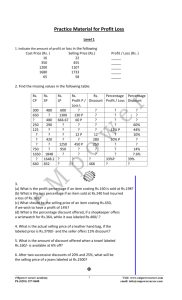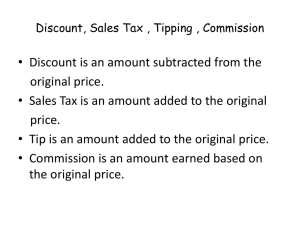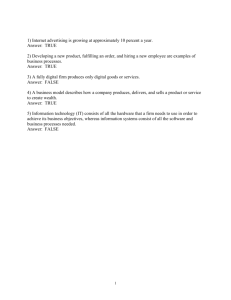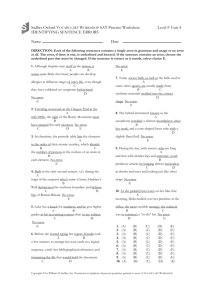profit-loss-class-work
advertisement
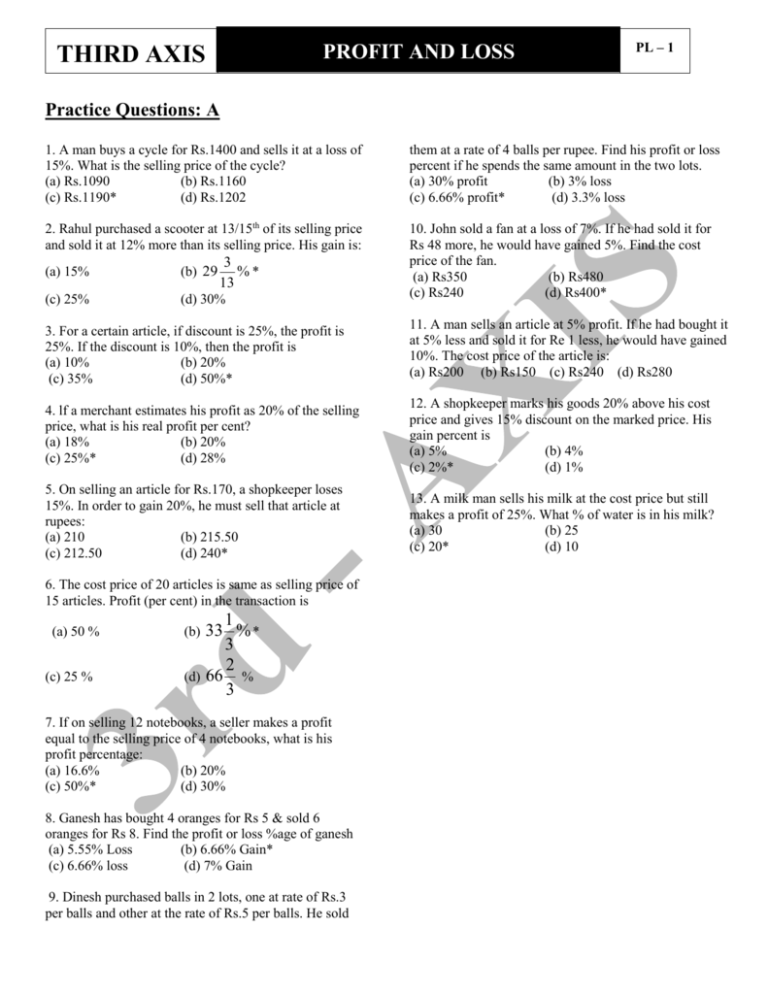
PROFIT AND LOSS THIRD AXIS PL – 1 Practice Questions: A 1. A man buys a cycle for Rs.1400 and sells it at a loss of 15%. What is the selling price of the cycle? (a) Rs.1090 (b) Rs.1160 (c) Rs.1190* (d) Rs.1202 them at a rate of 4 balls per rupee. Find his profit or loss percent if he spends the same amount in the two lots. (a) 30% profit (b) 3% loss (c) 6.66% profit* (d) 3.3% loss 2. Rahul purchased a scooter at 13/15th of its selling price and sold it at 12% more than its selling price. His gain is: 10. John sold a fan at a loss of 7%. If he had sold it for Rs 48 more, he would have gained 5%. Find the cost price of the fan. (a) Rs350 (b) Rs480 (c) Rs240 (d) Rs400* 3 %* 13 (a) 15% (b) 29 (c) 25% (d) 30% 3. For a certain article, if discount is 25%, the profit is 25%. If the discount is 10%, then the profit is (a) 10% (b) 20% (c) 35% (d) 50%* 11. A man sells an article at 5% profit. If he had bought it at 5% less and sold it for Re 1 less, he would have gained 10%. The cost price of the article is: (a) Rs200 (b) Rs150 (c) Rs240 (d) Rs280 4. lf a merchant estimates his profit as 20% of the selling price, what is his real profit per cent? (a) 18% (b) 20% (c) 25%* (d) 28% 12. A shopkeeper marks his goods 20% above his cost price and gives 15% discount on the marked price. His gain percent is (a) 5% (b) 4% (c) 2%* (d) 1% 5. On selling an article for Rs.170, a shopkeeper loses 15%. In order to gain 20%, he must sell that article at rupees: (a) 210 (b) 215.50 (c) 212.50 (d) 240* 13. A milk man sells his milk at the cost price but still makes a profit of 25%. What % of water is in his milk? (a) 30 (b) 25 (c) 20* (d) 10 6. The cost price of 20 articles is same as selling price of 15 articles. Profit (per cent) in the transaction is (a) 50 % (c) 25 % 1 33 % * 3 2 (d) 66 % 3 (b) 7. If on selling 12 notebooks, a seller makes a profit equal to the selling price of 4 notebooks, what is his profit percentage: (a) 16.6% (b) 20% (c) 50%* (d) 30% 8. Ganesh has bought 4 oranges for Rs 5 & sold 6 oranges for Rs 8. Find the profit or loss %age of ganesh (a) 5.55% Loss (b) 6.66% Gain* (c) 6.66% loss (d) 7% Gain 9. Dinesh purchased balls in 2 lots, one at rate of Rs.3 per balls and other at the rate of Rs.5 per balls. He sold THIRD AXIS PL – 2 PROFIT AND LOSS Practice Questions: B (c) 28 %* 1. A man sells 2 horses at the same price. On one he makes a profit of 10% and on the other he loses 10%. On the whole he: (a) makes no profit no loss (b) makes a profit of 1% (c) suffers a loss of 1 %* (d) suffers a loss of 2% 8. The difference between a discount of 40 % and 10% on Rs.500 and discounts of 30 % and 20 % on the same amount is (a) Rs.25 (b) nil (c) Rs.20 (d) Rs.10* 2. A man sells 2 houses at the same price. On one he makes a profit of 20% and on the other he loses 10%. On the whole he: (a) makes no profit no loss (b) makes a profit of 1.42% (c) suffers a loss of 1.4 % (d) suffers a loss of 2.85%* 9. A dishonest shopkeeper professes to sell pulses at his cost price. But he uses a false weight of 950 gram for a kilogram. His gain is: (a) 6% (b) 5.26%* (c) 5% (d) 6.5% 3. The C. P. of two washing machines taken together is Rs.18000. If by selling one at a profit of 25% & other at a loss of 20%, there is no loss or gain in the whole transaction, then the C.P. of two watches are respectively: (a) Rs.8000, Rs.10000* (b) Rs.10000, Rs.8000 (c) Rs.9000, Rs.9000 (d) Rs.7000, Rs.11000 10. A grocer purchased 80 kg of sugar at Rs 13.50 per kg and mixed it with 120 kg sugar at Rs 16 per kg. At what rate should he sell the mixture to gain 16%? (a) Rs17 per kg (b) Rs17.40 per kg* (c) Rs16.5 per kg (d) Rs16 per kg 4. Two electronic musical instruments were purchased for Rs 8000. The first was sold at a profit of 40% and the second at loss of 40%. If the selling price was the same in both the cases, what was the cost price of two electronic musical instruments? (a) Rs2000, Rs5000 (b) Rs2200, Rs5500 (c) Rs2400, Rs5000 (d) Rs2400, Rs5600* 5. A man bought a horse and a carriage for Rs.3000. He sold the horse at a gain of 20% and the carriage at a gain of 10%, thereby gaining 17% on the whole. Find the cost of the carriage. (a) Rs.900 (b) Rs.980 (c) Rs.800 (d) Rs.2100* 6. A man bought a book and a bag for Rs.1550. He sold the book at a gain of 5% and the bag at a gain of 8%, thereby gaining Rs.100 on the whole. Find the cost of the book. (a) Rs.800* (b) Rs.750 (c) Rs.900 (d) Rs.700 7. Successive discount of 10 % and 20 % is equivalent to a single discount of (a) 30 % (b) 15 % (d) 26 % 11. On selling a chair at 7% loss and a table at 17% gain, a man gains Rs. 296. If he sells the chairs at 7% gains and the table at 12% gain, then he gains Rs. 400. The actual price of the table is : (a) Rs.1600 (b) Rs.1400 (c) Rs.2350 (d) Rs.2400* 12. A tradesman gives 4% discount on the marked price and gives 1 article free for buying every 15 articles and thus gains 35%. The marked price is above the cost price by? (a) 20% (b) 39% (c) 40% (d) 50%* 13. The ratio to C.P. to MRP is 2:3 and ratio of profit percent to discount percent is 3:2. Find the profit percent (a) 10% (b) 15% (c) 20% (d) 25%* 14. A milk man makes a profit of 20% on the sale of milk. If he were to add 10% water to the milk, by what %would his profit increase? 40 3 (a) 30 (b) (c) 12* (d) 10 PL – 3 PROFIT AND LOSS THIRD AXIS Practice Questions: C 1. CP 1200 --------? 3000 ? 9000 ---------- SP ? 1500 2500 2500 4000 CP ? SP ------2500 ? ? P/L --------+300 -------------------------2000 300 P/L % +12 ? +25% ? -9.09% ? +25% MRP 2000 ? 5000 D% 10% 16.66% 10% a) 1500 20% 2000* 25% 5000 20% 1200 P/L % +20% -25% 2. On the eve of Gandhi Jayanti, Gandhi Ashram declared a 25% discount on silk. If selling price of a silk saree is Rs.525m what is its marked price? (a) Rs.700* (b) Rs.725 (c) Rs.750 (d) Rs.775 1 10 of its cost price. Find his cost price. (a) Rs.850 (b) Rs.810* (c) Rs.851 (d) Rs.840 5. An article is sold at a certain price. By selling It at 2/3 of that price one loses 10%. Find the gain percent at original price. (a) 15% 3 (b) 29 % 13 (c) 35%* (d) 30% 6. Rahul buys an old T.V. for Rs. 4700 and spends Rs. 800 on its repairs. If he sells the T.V. for Rs. 5800, his gain percent is: 4 (a) 4 % 7 5 (b) 5 %* 11 (c) 10% (d) 12% a) 1800 2500 6000* c) 1800 16.6% 3000 16.66%* 4400* 18.18% 1800 b) 1500* 4000 4000 d) 1320 15% 500 20% 3000 22.22%* 900 c) 1600 2000 8000 d) 1000 3000* 3000 7. An electric iron was sold at a profit of 15%. Had it been sold for Rs.600, the profit would have been 20%. The former selling price of the electric iron is: (a) Rs.500 (b) Rs.540 (c) Rs.575* (d) Rs.600 8. Kabir buys an article with 25% discount on its marked price. He makes a profit of 10% by selling it at Rs.660. The marked price is (a) Rs.600 (b) Rs.685 (c) Rs.700 (d) Rs.800* 3. A discount of 16% on the marked price of a book enables a man to buy a pen which costs Rs 80. How much did he pay for the book? (a) Rs.420* (b) Rs.450 (c) Rs.480 (d) Rs.495 4. A man sold his book for Rs 891, there by gaining b) 1344* 25%* 1500 15% 6000 10% 1500* 9. 100 oranges are bought at the rate of Rs.350 and sold at the rate of Rs.48 per dozen. The percentage of profit or loss is: 2 % gain * 7 2 (c) 14 % loss 7 (a) 14 (b) 15% gain (d) 15% loss 10. 400 mangoes were bought at Rs. 125 per hundred and were sold for a profit of Rs. 100. The selling price per dozen was: 1 2 (a) Rs. 15 (b) Rs. 16 (c) Rs. 18 (d) Rs. 20* 11. A man gains 10% by selling a certain article for a certain price. If he sells it at double the price, the profit made is : (a) 20% (b) 60% (c) 100% (d) 120% * THIRD AXIS PL – 4 PROFIT AND LOSS 12. lf a merchant estimates his profit as 50% of the selling price, what is his real profit per cent? (a) 18% (b) 20% (c) 100%* (d) 28% 13. By selling an article for Rs 45, a shopkeeper loses 20%. For how much should he sell it to gain 20% on it? (a) Rs.50 (b) Rs.67.50* (c) Rs.60.50 (d) Rs.65 14. On selling an article for Rs. 1200, a shopkeeper profits 20%. If he sell that article at Rs.700, what will be the loss or profit percentage. (a) profit 20% (b) profit 10% (c) loss 25% (d) loss 30%* 15. Five kg of butter was bought by a shopkeeper for Rs 300. One kg becomes unsaleable. He sells the remaining in such a way that on the whole he incurs a loss of 10%. At what price per kg was the butter sold? (a) Rs.67.50* (b) Rs.52.50 (c) Rs.60 (d) Rs.72.50 16. 2/3rd of a consignment was sold at a profit of 6% and the rest at a loss of 3%. If however, there was an overall profit of Rs.540, the value of the consignment was: (a) Rs.1620 (b) Rs.4860 (c) Rs.5400 (d) Rs.18000* 17. A shopkeeper bought 30 kg of wheat at the rate of Rs. 45 per kg. He sold forty per cent of the total quantity at the rate of Rs.50 per kg. Approximately, at what price per kg should he sell the remaining quantity to make 25 per cent overall profit? (a) Rs. 54 (b) Rs. 52 (c) Rs. 50 (d) Rs. 60* (e) Rs. 56 18. If the manufacturer gains 10%, the wholesale dealer 15% and the retailer 25%, then find the cost of production of a table, the retail price of which is Rs 1265? (a) Rs.800* (b) Rs.1000 (c) Rs.900 (d) Rs.600 19. A sells an article which costs him Rs 400 to B at a profit of 20%. B then sells it to C, making a profit of 10% on the price he paid to A. How much does C pay to B? (a) Rs.472 (b) Rs.476 (c) Rs.528* (d) Rs.532 20. A manufacturer sells to the wholesaler at a profit of 16.66%. The wholesaler sells to the dealer at a profit of 9.09%. The dealer sells to a retailer at a profit of 10% and the retailer to the customer at a profit of 14.28%. If the customer paid Rs.464 for the article, find the cost of manufacturing the product incurred by the manufacturer. (a) Rs.2400 (b) Rs.2900* (c) Rs.2528 (d) Rs.5600 21. Meera purchased an item for Rs. 62000 and sold it at loss of 25%. With that amount she purchased another item and sold it at a gain of 30%. What was her overall gain/loss? (a) Loss of Rs.1560 (b) Profit of Rs.150 (c) Loss of Rs.1550* (d) Profit of Rs.1550 (e) None of these. 22. The cost price of 25 articles is same as selling price of 20 articles. Profit (per cent) in the transaction is (a) 50 % (c) 25 %* 1 33 % 3 2 (d) 66 % 3 (b) 23. The cost of 20 articles is the same as the selling price of x articles. If the profit is 25%, then the value of x is: (a) 24 (b) 10 (c) 16 * (d) 15 24. If on selling 25 notebooks, a seller makes a profit equal to the selling price of 5 notebooks, what is his profit percentage: (a) 16.6% (b) 25%* (c) 50% (d) 30% 25. On selling 17 books at Rs.720, there is a loss equal to the cost price of 5 balls. The cost price of a book is: (a) 60* (b) 30 (c) 33 1 3 (d) 50 26. A man sold 10 eggs for 5 rupees and gained 20%.How many eggs did he buy for 5 rupees? (a) 10 eggs (b) 12 eggs* (c) 14 eggs (d) 16 eggs 27. A person sells 36 oranges per rupee and suffers a loss of 4%. Find how many oranges per rupee to be sold to have a gain of 8%? (a) 30 (b) 31 (c) 32* (d) 33 THIRD AXIS PL – 5 PROFIT AND LOSS 28. Dinesh purchased balls in two lots, one at rate of Rs. 3 per balls and other at rate of Rs. 5 per balls. He sold them at a rate of Rs. 4 per balls. Find his profit or loss percent if he purchases the same number of balls in the two lots. (a) 2% loss (b) 8% loss (c) 2% profit (d) no profit no loss* 29. Dinesh purchased balls in 2 lots, one at rate of Rs. 3 per balls and other at the rate of Rs. 5 per balls. He sold them at a rate of 4 balls per rupee. Find his profit or loss percent if he spends the same amount in the two lots. (a) 30% profit (b) 3% loss (c) 6.66% profit* (d) 3.3% loss 30. Dinesh purchased balls in two lots, one at rate of 3 balls for a rupee and other at rate of 5 balls for a rupee. He sold them at a rate of 4 balls per rupee. Find his profit or loss percent if he purchases the same number of balls per rupee and not rupees per ball (a) 0.5% loss (b) 6.25% loss* (c) 5% profit (d) 6% profit 31. Dinesh purchased balls in two lots, one at rate of 3 balls for a rupee and other at rate of 5 balls for a rupee. He sold them at a rate of 4 balls per rupee. Find his profit or loss percent if he spends the same amount of rupees on the two lots. (a) 10% loss (b) 1% profit (c) 2% loss (d) no profit no loss* (a) Rs150 (c) Rs170 (b) Rs160* (d) Rs180 36. A tradesman is marketing his goods 20% above the cost price of the goods. He gives 10% discount on cash payment, find his gain percent. (a) 12% (b) 8%* (c) 15% (d) 18% 37. A man get 20% profit after allowing discount of 20%. By how much he increased the marked price. (a) 20% (b) 25% (c) 50%* (d) 75% 38. A trader makes up his goods by 27.27% and then offers a discount of 8.33%. Find his profit percentage. (a) 16.6%* (b) 18.18% (c) 25% (d) 6.5% 39. A man buys two steel chairs for Rs 500 each. On one he gains 20% and on other, he loses 12%. How much does he gain or lose in the whole transaction? (a) 1.5% gain (b) 4% gain* (c) 5% loss (d) 4% loss 40. Rohan buys two commodities for Rs. 60000 each. He sells one at a profit of 20% and sells the other at a loss of 20%. Find his overall profit or loss percent and also the amount of profit or loss. (a) makes no profit no loss* (b) makes a profit of 1% (c) suffers a loss of 1 % (d) suffers a loss of 2% 32. A shopkeeper sold an book at a loss of 20%. If the selling price had been increased by Rs. 100, there would have been a gain of 5%. What was the cost price of the book? (a) Rs.450 (b) Rs.400* (c) Rs.550 (d) Rs.575 41. A man sells 2 horses at the same price. On one he makes a profit of 20% and on the other he loses 20%. On the whole he: (a) makes no profit no loss (b) makes a profit of 1% (c) suffers a loss of 1 %* (d) suffers a loss of 4% 33. The cost price of an article, which on being sold at a gain of 12 % yields Rs. 6 more than when it is sold at a loss of 12 % , is (a) Rs 24 (b) Rs 25* (c) Rs 30 (d) Rs 20 42. Ram sold two bicycles, each for Rs. 990, made 10% profit on the first and 10% loss second. What is the total cost price? (a) Rs. 2000* (b) Rs. 1980 (c) Rs. 891 (d) Rs. 1089 34. The difference in selling prices of a heater at gains of 43. A man sells two commodities for Rs. 4000 each, neither losing nor gaining in the deal. If he sold one commodity at a gain of 25%, the other commodity is sold at a loss of: (a) 16.6%* (b) 18.18% (c) 25% (d) 6.5% 1 5% and 7 % is Rs. 1.25. The cost price of the heater is: 2 (a) Rs. 45 (c) Rs. 52.50 (b) Rs. 50* (d) Rs. 53.75 35. A man sells an article at a gain 15%. If he had bought it at 10% less and sold it for Rs 4 less, he would have gained 25%. Find the cost price of the article. THIRD AXIS PROFIT AND LOSS 44. A man purchases two watches at Rs 560. He sells one at 15% profit and other at 10% loss. Then he neither gain nor loss. Find the cost price of each watch. (a) Rs224, Rs300 (b) Rs200, Rs300 (c) Rs224, Rs336* (d) Rs200, Rs336 PL – 6 52. Three dealers 'A', 'B' and 'C' offer an article at the same list price. 'A' allows a series of discount of 25% and 15%, 'B' allows a series of discount of 10% and 30%, while 'C' offers a single discount of 36%. Then: (a) all the offers are the same (b) A's offer is best (c) B' s offer is best* (d) C's offer is best 45. Two electronic musical instruments were purchased for Rs 8000. The first was sold at a profit of 40% and the second at loss of 40%. If the selling price was the same in both the cases, what was the cost price of two electronic musical instruments? (a) Rs2000, Rs5000 (b) Rs2200, Rs5500 (c) Rs2400, Rs5000 (d) Rs2400, Rs5600* 53. The list price of a watch is Rs 160. A retailer bought the same watch Rs 122.40. He got two successive discounts one at 10% and the other at a rate which was not legible. What is the second discount rate? (a) 12% (b) 14% (c) 15%* (d) 18% 46. A man purchases two clocks A and B at a total cost of Rs.650. He sells A with 20% profit and B at a loss of 25% and gets the same selling prices for both the clocks. What are the purchasing prices of A and B respectively? (a) Rs.200 and Rs.450 (b) Rs.250 and Rs.400* (c) Rs.350 and Rs.300 (d) Rs.22\0 and Rs.430 54. By selling an umbrella for Rs 30, a merchant gains 20%. During a clearance sale, the merchant allows a discount of 10% off the marked price (the price at which he used to sell). Find his gain per cent. (a) 6% (b) 7% (c) 8%* (d) 9% 47. A man bought a horse and a carriage for Rs.3000. He sold the horse at a gain of 20% and the carriage at a loss of 10%, thereby gaining 2% on the whole. Find the cost of the horse. (a) Rs.1200* (b) Rs.1980 (c) Rs.891 (d) Rs.1089 55. A shopkeeper purchased a table marked at Rs 200 at successive discount of 10% and 15% respectively. He spent Rs 7 on transportation and sold the table for Rs 200. Find his gain %? (a) No loss or gain (b) 25%* (c) 30% (d) 40% 48. A fruit seller has 24 kg of apples. He sells a part of these at a gain of 20% and the balance at a loss of 5%. If on the whole he earns a profit of 10%, the amount of apples sold at a loss is : (a) 4.6 kg (b) 9.6 kg* (c) 5.6 kg (d) 6.2 kg 56. A dishonest shopkeeper professes to sell pulses at his cost price. But he uses a false weight of 900 gram for a kilogram. His gain is: (a) 10% (b) 11.11%* (c) 15% (d) 6.5% 49. A man bought a plot and a flat for Rs.13900. He sold the plot at a gain of 14% and the flat at a gain of 11%, thereby gaining Rs.1754 on the whole. Find the cost of the plot. (a) Rs.6400 (b) Rs.7000 (c) Rs.7500* (d) Rs.8000 50. A single discount that is equivalent to a discount series of 30%, 20% and 10% is: (a) 60% (b 50% (c) 49.6% * (d) 50.4% 51. The difference between a discount of 40 % on Rs. 500 and two successive discounts of 36 % and 4 % on the same amount is (a) Rs 2 (b) nil (c) Rs 1.93 (d) Rs 7.20 57. A dishonest dealer sells his goods at the cost price but still earns a profit of 25% by underweighing. What weight does he use for a kg? (a) 750g (b) 800g* (c) 825g (d) 850g 58. A grocer purchased 80 kg of sugar at Rs 13.50 per kg and mixed it with 120 kg sugar at Rs 16 per kg. At what rate should he sell the mixture to gain 16%? (a) Rs17 per kg (b) Rs17.40 per kg* (c) Rs16.5 per kg (d) Rs16 per kg 59. A trader mixes two varieties of teas from two different tea gardens, one costing Rs. 75 per kg and the other Rs. 100 per kg in the ratio 7:3. If the mixture is sold at Rs. 90.75 per kg, his profit or loss is: (a) 10% profit* (b) 10% loss 1 3 (c) 2 % profit (d) No profit no loss THIRD AXIS PROFIT AND LOSS 60. A trader mixes two varieties of teas from two different tea gardens, one 40kg @ Rs. 70 per kg and the other X kg @ Rs. 90 per kg. if he sold mixture at Rs. 102 per kg, and making profit of 20%. Then find the value of X (a) 150kg (b) 120kg* (c) 100kg (d) 80kg PL – 7 63. A merchant buys 10 drums of kerosene oil. If he sells kerosene oil at Rs. 8 a litre, he loses Rs. 320. On the other hand if he sells it at Rs. 9.60 a litre, he gains Rs. 256. The number of litres of kerosene in a drum and the cost price per drum is : . (a) 8 Iitres: Rs. 320 (b) 36 litres; Rs. 420 (c) 36 litres; Rs. 320* (d) 50 litres; Rs. 432 61. On selling a pen at 5% loss and a book at 15% gain, Karan gains Rs 7. If he seIls the pen at 5%, and the book at 10% gains, then he gains Rs 13. The actual price of the book is: (a) Rs100 (b) Rs80* (c) Rs10 (d) Rs40 64. A person bought 20 litres of milk at the rate of Rs. 8 per litre. He got it churned after spending Rs. 10 and got 5 kg of cream and 20 litres of toned milk. If he sold the cream at Rs. 30 per kg and toned milk at Rs. 4 per litre, his profit in the transaction is: (a) 25% (b) 35.3%* (c) 37.5% (d) 42.5% 62. On selling a chair at 7% loss and a table at 17% gain, a man gains Rs. 296. If he sells the chairs at 7% gains and the table at 12% gain, then he gains Rs. 400. The actual price of the table is: (a) Rs.1600 (b) Rs.1400 (c) Rs.2350 (d) Rs.2400* 65. When a producer allows 20% commission on the retail price of his product, he earns a profit of 33.3%. What would be his profit percent if the commission is reduced to 10%? (a) 45% (b) 40% (c) 50%* (d) 60%

